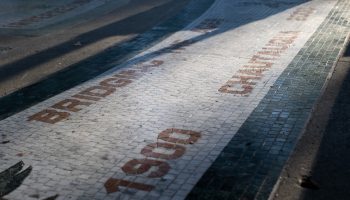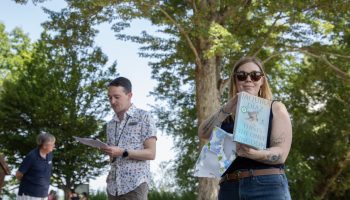
At 7:30 p.m. Saturday in the Amphitheater, Houston Ballet will grace the stage for an evening of ballet accompanied by the Chautauqua Symphony Orchestra and soprano Aubry Ballarò, under the baton of Music Director and Principal Symphonic Conductor Rossen Milanov.
The evening’s program includes composer Adolphe Adam’s “Divertissements” from Act I of Giselle, Pyotr Tchaikovsky’s the grand pas de deux from Act III of The Sleeping Beauty, Boris Asafiev’s “Flames of Paris” pas de deux and Richard Strauss’ Four Last Songs.
While Houston Ballet II performed Monday night with students of Chautauqua’s School of Dance, Saturday’s program will be quite different, and Houston Ballet Artistic Director Julie Kent said she believes audiences will enjoy both. Ballarò will sing for the Strauss finale, composed at 84 years old in 1948 — one year before his death. A showcase of his mastery in Romantic style, Strauss lived through two World Wars and instilled a sense of longing into the melody of Four Last Songs regarding the destruction of life and art.
“It’s like an acceptance of death, but it’s not sad; it’s an acceptance with serenity, beauty and peace,” Ballarò said. “ ‘This has been a very long journey, and we’re weary wanderers. Maybe this is our time to rest. Maybe this is death — is it?’ And that’s just this big question mark at the end. It’s really beautiful.”
Through its careful reflection, Four Last Songs serves as a reminder of beauty’s importance to humanity.
“The world is a tumultuous place, and to have this reminder as a kind of balm through the soul is really important to us right now. It will always be important to us, but we can always find our own way of relating to them,” Ballarò said. “It’s just so gorgeous.”
As Ballarò has previously performed in Orff’s Carmina Burana in collaboration with ballet, her experience has led to an understanding of what the dancers require.
“The biggest challenge is that we have to be really on the same page with them, and we can’t do anything necessarily that we might feel in the moment that goes too far off the path they’ve been rehearsing on,” Ballarò said.
Like Ballarò, Kent stressed the importance of communication and collaboration between parties in the moment.
“It’s like the highest level of communication when we’re responding to stimulus that you’re anticipating will be of a certain tempo, but you’re also working intimately with 70-plus other people and one person is the conduit between all that energy,” Kent said. “You feel the culmination of the talents and energy and concentration of so many artists and it’s a thrilling experience.”
To Kent, the key to success when dancers are accompanied by live music is this communication and trust between parties.
“You have to be responsive, you have to be listening and you have to be flexible,” she said. “You have to just make it happen with what you hear.”
In addition to the difficulties that an interdisciplinary concert brings, Ballarò finds that Four Last Songs is like training for a marathon. She believes the lines written for soprano are some of the most strenuous to sing because they’re very long with little room to breathe.
“All of the lines that (Strauss) writes for soprano are really difficult. Actually, they are some of the most difficult lines to sing, but it’s some of the most gratifying music to sing, too, because you’re among all of these beautiful horn and violin solos,” Ballarò said. “It’s gorgeous.”
A Chautauqua Opera Studio Artist in 2015 and guest artist last season, Ballarò returns for a slightly ironic performance on her birthday, as she reflects on her own journey through life.
“It’s the best birthday gift I could have possibly asked for,” Ballarò said. “To be able to make music with one of the greatest orchestras along with one of the best conductors and one of my dearest friends for an audience is just a dream.”
Having worked with Milanov and performed for Chautauqua many times over, Ballarò believes there is something unique about the goodness of both.
“Rossen, not only is he one of the best conductors in our business and respected everywhere, but he is different. He is generous and kind. With other colleagues who also have worked with him several times, we all talk about how we’ve never seen a conductor smile so much when we work with them. He brings this beautiful amount of joy that we don’t often come across — at least not in the abundance that he gives it,” Ballarò said. “In the same way that Rossen is so generous, the audience in Chautauqua is beautifully receptive to anything that I’ve seen or been a part of; when an audience is so receptive, it makes you want to give them everything you have.”
Kent said the added element of an orchestra heightens the viewer’s sensitivity and immersion in the art, especially when one considers the tremendous investment in the craft it requires to produce such an artistic collaboration.
“With an orchestra, it’s a sensitivity and then you feel, as an audience member, the talent and investment of so many people,” she said. “That makes it even more marvelous, (to think) about the human experience and human talents that people can do things that are so beautiful — and, when you think about it further, how much of their life each individual person has invested just to get to that level.”
Kent was a student in Chautauqua’s School of Dance and has since established a now three-year-long partnership between Chautauqua Institution and Houston Ballet. To Chautauquans, Kent’s message is simple: The company is thrilled to return once more to the grounds.
“We’re just thrilled to be back and looking forward to sharing our beautiful company with the Chautauqua audience,” she said.




